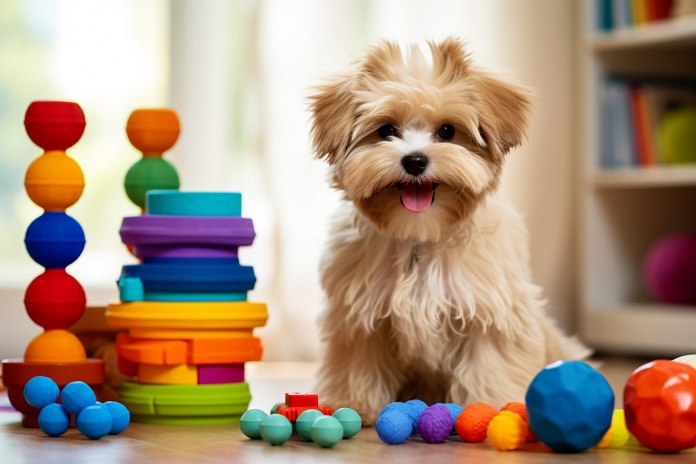
The 10th month of your dog’s life can be a tricky age. Your pup will look like a fully grown dog, but there is still a lot of growth and development happening at a slower pace. Your puppy will still need guidance and attention, and will crave rewards. While some puppy behaviors may still appear occasionally, your dog is well on its way to adulthood. When planning activities for your 10-month old, keep in mind that they are still considered a puppy and their bones and joints are still developing. Avoid activities that are too strenuous. Here are a few ideas for activities with your 10-month old dog.
1️⃣ Swimming
Difficulty: Normal
Items Needed: Life Vest, Toys (Optional)
Most dogs love playing in water, and it’s great for growing pups too. Water activities are low-impact, so they won’t stress their bones and joints. It’s also refreshing and fun. Introducing water to puppies early helps them learn a new skill and become confident in aquatic settings. The best time to swim with your dog is on clear, warm days. Swimming can be free or inexpensive, depending on where you go.
Step 1: Find a swimming spot.
Before you can go swimming, you need to find a place to swim. There are many options to choose from. You can start with a simple inflatable pool in your backyard or your own pool if you have one. You can also find a public pool that allows dogs. If you prefer a more natural setting, you can go to a lake or river. However, consider your dog’s abilities. For 10-month-old dogs, a swimming pool or calm lake are good options.
Step 2: Enjoy the water!
Once you’ve found the perfect spot, gather all the necessary things and head out. It’s a good idea to have a life vest for your dog and bring some floating toys for them to play with. Don’t forget to bring food and water for your dog as well. Let your dog have fun in the water, but remember to take breaks to feed and hydrate them.
Step 3: Have a great time!
Enjoy your time swimming with your dog. Make sure to supervise them closely and ensure their safety. Pay attention to their behavior and comfort level in the water. Take breaks as needed and have a wonderful and refreshing experience together!
2️⃣ Fetching Fun
Difficulty: Easy
Items Needed: Toy, Treats, Food, Water
Dogs absolutely love playing fetch. It’s a classic game that dog owners love because it keeps their furry friends physically and mentally engaged. And the best part? It’s not too tiring for young pups. All they need to do is run a bit and stay alert. You can play fetch almost anywhere, like in your backyard, a dog park, or on the beach. And the cherry on top is that it doesn’t cost a thing!
Step 1: Look for a place to play in.
Playing a game of fetch is simple, but first, you need to find a good spot to play in. Fetch can be played anywhere, but it’s best to choose a new place that your dog hasn’t been to before. This will make your dog more excited and engaged in the game.
Step 2: Get your dog fetchin’!
While fetch is a straightforward game, your puppy might need some guidance on how to play. If your dog is new to fetch, you can demonstrate how to chase and retrieve the toy. Your dog will quickly catch on to the game. For puppies, it’s best to use a soft or small toy that is easy for them to retrieve. Remember not to make your dog work too hard – keep the play sessions to around 10 minutes and give them breaks to rest and drink water.
Step 3: Keep it fun and varied.
To keep your dog interested, change up the location of your fetch games from time to time. This will prevent boredom and make the game more enjoyable for your dog. Remember to always supervise your dog during playtime and provide plenty of praise and rewards for their efforts.

3️⃣ Trick Training
Difficulty: Normal
Items Needed: Treats
The optimal time to teach a dog new tricks is when they are young, as they are more alert and responsive to commands. At around 10 months old, dogs are already physically and mentally developed, making it an ideal age for training. Trick training provides both physical and mental exercise for your dog. The best part is that you can do it at home without needing any extra equipment or expenses. If you prefer a different environment, you can also take your dog to a park for training. This activity allows you to teach your dog discipline while also strengthening your bond with them.
Step 1: Start with simple tricks
When it comes to training your dog to do tricks, start with the basics. This includes common commands such as “come”, “sit”, or “stay”. Bring your dog to your practice area and list down the commands you want to start with. Make sure you have your dog’s attention and voice out your commands clearly and concisely.
Step 2: Reward your dog
The best way to get your dog to learn new tricks is to reward their efforts. Dogs love positive reinforcement, whether it’s through affectionate gestures like pats on the head or belly rubs, or giving them doggy treats. Keep training sessions short, ideally only 10 minutes, as your dog’s attention span is limited. Take short breaks in between before starting over again.
At 10 months old, dogs are full of life and energy. They still have a lot of maturing and developing to do, both physically and mentally. This is a great time to teach them new things and help them build their stamina. Consider trying out some of the activities mentioned above for your growing pup.